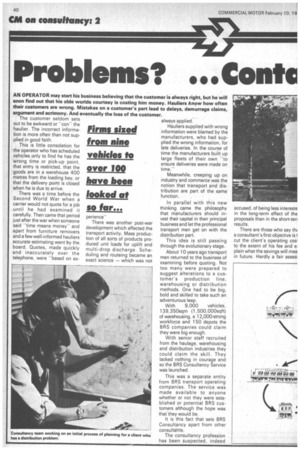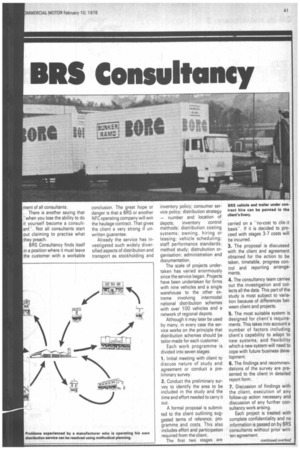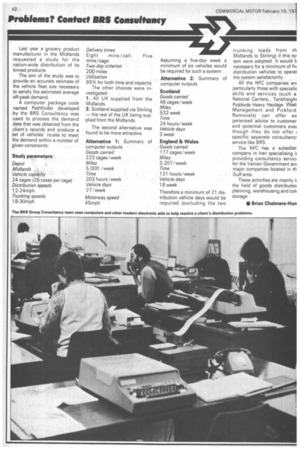Problems? ...Conte
Page 42

Page 43

Page 44

If you've noticed an error in this article please click here to report it so we can fix it.
ORS Consultancy
AN OPERATOR may start his business believing that the customer is always right, but he will soon find out that his olde vvorlde courtesy is costing him money. Hauliers know how often their customers are wrong. Mistakes on a customer's part lead to delays, demurrage claims, argument and acrimony. And eventually the loss of the customer.
The customer seldom sets out to be awkward or "con" the haulier. The incorrect information is more often than not supplied in good faith.
This is little consolation for the operator who has scheduled vehicles only to find he has the wrong time or pick-up point, that entry is restricted, that the goods are in a warehouse 400 metres from the loading bay, or that the delivery point is closed when he is due to arrive.
There was a time before the Second World War when a carrier would not quote for a job until he had examined it carefully. Then came that period just after the war when someone said "time means money"' and apart from furniture removers and a few well-informed hauliers accurate estimating went by the board. Quotes, made quickly and inaccurately over the telephone.. were "'based on ex perience" There was another post-war development which affected the transport activity. Mass production of all sorts of products produced unit loads for uplift and multi-drop discharge. Scheduling and routeing became an exact science — which was not always applied.
Hauliers supplied with wrong information were blamed by the manufacturers, who had supplied the wrong information, for late deliveries. In the course of time the manufacturers built up large fleets of their own "to ensure deliveries were made on time.'' Meanwhile, creeping up on industry and commerce was the notion that transport and distribution are part of the same function.
In parallel with this new thinking came the philosophy that manufacturers should invest their capital in their principal business and let the professional transport men get on with the distribution part.
This idea is still passing through the evolutionary stage.
About 10 years ago transport men returned to the business of examining before quoting. Not too many were prepared to suggest alterations to a customer's production line, warehousing or distribution methods. One had to be big, bold and skilled to take such an adventurous leap.
With 9,000 vehicles, 139,350sqm (1 ,500,000sqft) of warehousing, a 12,000-strong workforce and 150 depots the BRS companies could claim they were big enough.
With senior staff recruited from the haulage, warehousing and distribution industries they could claim the skill. They lacked nothing in courage and so the BRS Consultancy Service was launched.
This was a separate entity from BRS transport operating companies. The service was made available to anyone whether or not they were established or potential BRS customers although the hope was that they would be.
It is this fact that sets BRS Consultancy apart from other consultahts.
The consultancy profession has been suspected, indeed accused, of being less intereste in the long-term effect of the proposals than in the short-ten results.
There are those who say tl-u a consultant's first objective is t cut the client's operating cos: to the extent of his fee and e: plain what the savings will mea in future. Hardly a fair asses:
ment of all consultants.
There is another saying that when you lose the ability to do it yourself become a consultant-. Not all consultants start out claiming to practise what they preach.
BRS Consultancy finds itself in a position where it must leave the customer with a workable conclusion. The great hope or danger is that a BRS or another NFC operating company will win the haulage contract. That gives the client a very strong if unwritten guarantee.
Already the service has investigated such widely diversified aspects of distribution and transport as stockholding and inventory policy; consumer service policy; distribution strategy — number and location of depots; inventory control methods; distribution costing systems; owning, hiring or leasing; vehicle scheduling; staff performance standards; method study; distrubution organisation; administration and documentation.
The scale of projects undertaken has varied enormously since the service began. Projects have been undertaken for firms with nine vehicles and a single warehouse to the other extreme involving intermodal national distribution schemes with over 100 vehicles and a network of regional depots.
Although it may later be used by many, in every case the service works on the principle that distribution schemes should be tailor-made for each customer.
Each work programme is divided into seven stages: 1. Initial meeting with client to discuss nature of study and agreement or conduct a preliminary survey.
2. Conduct the preliminary survey to identify the area to be included in the study and the time and effort needed to carry it out.
A formal proposal is submitted to the client outlining suggested terms of reference, programme and costs. This also includes effort and participation required from the client.
The first two stages are
BRS vehicle and trailer under contract hire can be painted in the client's livery,
carried on a "no-cost to clie,lt basis-. If it is decided to proceed with stages 3-7 costs will be incurred.
3. The proposal is discussed with the client and agreement obtained for the action to be taken, timetable, progress control and reporting arrangements.
4. The consultancy team carries out the investigation and collects all the data. This part of the study is most subject to variation because of differences between client and projects.
5. The most suitable system is designed for client's requirements. This takes into account a number of factors including client's capability to adapt to new systems, and flexibility which a new system will need to cope with future business development.
6. The findings and recommendations of the survey are presented to the client in detailed report form.
7. Discussion of findings with the client, execution of any follow-up action necessary and discussion of any further consultancy work arising.
Each project is treated with complete confidentiality and no information is passed on by BRS consultants without prior written agreement. Last year a grocery product manufacturer in the Midlands requested a study for the nation-wide distribution of its tinned products.
The aim of the study was to provide an accurate estimate of the vehicle fleet size necessary to satisfy the estimated average off-peak demand.
A computer package code named Pathfinder developed by the BRS Consultancy was used to process the demand data that was obtained from the .client's records and produce a set of vehicles' routes to meet the demand within a number of given constraints:
Study parameters: Depot Midlands Vehicle capacity 24 cages (25 cases per cage) Distribution speeds 12-24mph Trunking speeds 18-30mph Delivery times Eight mins/call. Five mins/cage Two-day criterion 200 miles Utilisation 85% for both time and capacity The other choices were investigated: 1. All UK supplied from the Midlands.
2. Scotland supplied via Stirling — the rest of the UK being supplied from the Midlands.
The second alternative was found to be more attractive.
Alternative 1: Summary of computer outputs Goods carried 223 cages/week Miles 5,000 /week Time 203 hours/week Vehicle days 27/week Motorway speed 45mph Assuming a five-day week a minimum of six vehicles would be required for such a system.
Alternative 2: Summary of computer outputs Scotland Goods carried 46 cages/week Miles 532 week Time 24 hours/week Vehicle days 3 week England & Wales Goods carried
177 cages/week
Miles 3,207 /week Time 131 hours/week Vehicle days 18 week Therefore a minimum of 21 distribution vehicle days would be required (excluding the two trunking loads from th Midlands to Stirling) if this sy: tern were adopted. It would necessary for a minimum of fiv distribution vehicles to operat the system satisfactorily.
All the NFC companies an particularly those with specialiE skills and services (such a National Carriers,, Tankfreight Pickfords Heavy Haulage, Wast Management and Pickford Removals) can offer ex perienced advice to customer and potential customers evei though they do not offer ; specific separate consultanc' service like BRS.
The NFC has a subsidiar company in Iran specialising ii
providing consultancy servic, for the Iranian Government an( major companies located in th Gulf area.
These activities are mainly ii the field of goods distributioi planning, warehousing and coli storage.
• Brian Chalmers-Hun












































































































